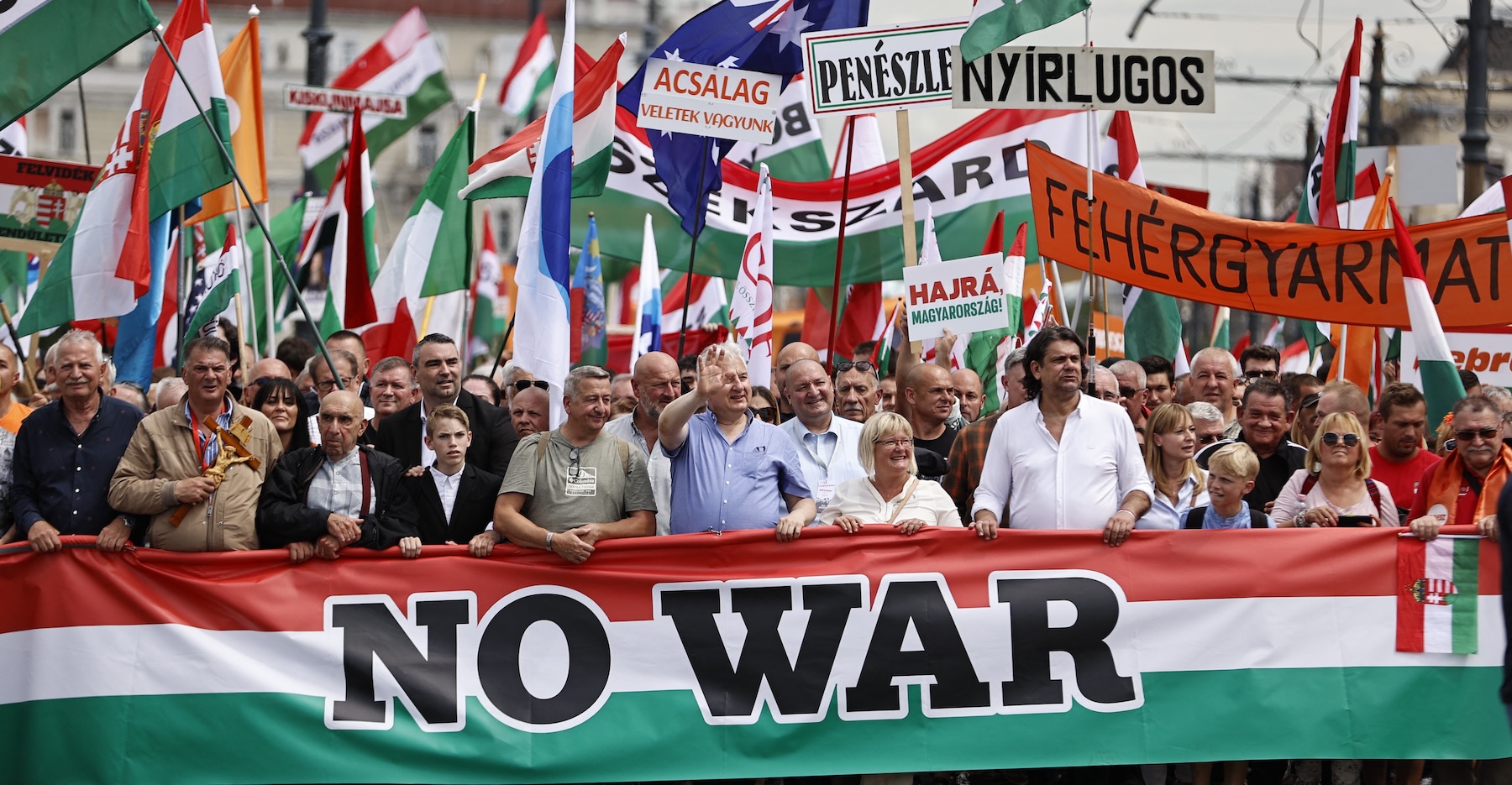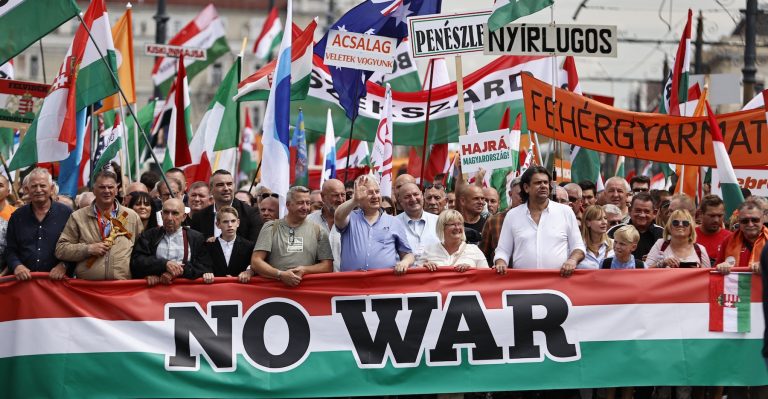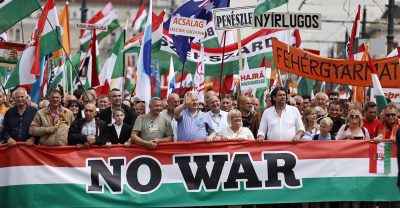The organization of domestic and international “peace movements” by Hungarian state and non-state actors – in collaboration with other international players – marks a new and troubling development in international politics, with far-reaching and lasting implications for both European stability and Ukraine’s potential success in the war.
Drawing on regional research, our article details how the Kremlin’s recalibration of far-right and far-left influence networks across Europe under the guise of “peace” has become a powerful political and communication tool, aimed at undermining Western unity in support of Ukraine and fueling “Ukraine fatigue” among European populations. An analysis by the Budapest-based Political Capital Institute.
Marching for Sovereignty: From Symbolic Protests to Electoral Triumphs
In the days of the Soviet Union, “peace” movements and marches were put on to blame the West as violent expansionists while masking Moscow’s true intention, which was global ideological and political expansion. So it is today in Viktor Orbán’s Hungary. Orbán’s government has turned the concept of peace into a political weapon, wielding it as a tool to consolidate domestic power and expand international influence. Hungarian peace activism labels political opposition and critics, domestic and foreign alike, as “warmongers” and forges pro-Kremlin alliances with like-minded “peace” organizations, holding peace marches organized by pro-government GONGOs (government organized non-governmental organizations) or fringe actors.
By 2024, peace marches in support of the Orbán government had become a key element of the ruling Fidesz-KDNP coalition’s political strategy. The marches mobilized tens of thousands of people to demonstrate against “external pressures,” especially in the context of the war in Ukraine. The most recent pro-government peace march was held on June 1, 2024 in Budapest as part of the ruling party’s campaign for the European Parliament elections. The protest echoed a main, and untrue, ruling party narrative: that only Fidesz-KDNP and their “sovereigntist” European allies could protect Europe and Hungary from an imminent “third world war.” This narrative positioned Fidesz-KDNP as standing against the “pro-war” EU, the US, NATO members supporting Ukraine, and the “foreign-funded” Hungarian opposition, while aligning the Hungarian government with autocratic regimes like Russia and China, presumably in return for diplomatic, political, or financial support. This rhetoric resonated with voters, and helped usher in a victory for Fidesz-KDNP in both the general election in 2022 and the European Parliament election in 2024.
Hungarian pro-peace messages are being pushed down for political gain from the top of the political elite. But the Kremlin also has political allies on both the far right and the far left trying to generate momentum for the “peace movement.”
The Kremlin’s Hand: Infiltrating Hungarian Peace Movements
The infiltration of Russian narratives into the Hungarian peace movement is a testament to the Kremlin’s long game. These narratives, which paint Russia as a victim of Western aggression, have found fertile ground in Hungary, particularly in fringe political movements. Over time, these ideas were nurtured and promoted by key figures within such movements – and then gradually moved from the fringes to the center of Hungarian political discourse.
Endre Simó, a founding member of the far-left Hungarian Social Forum, is a particularly significant example. Simó established the Hungarian Peace Circle (Magyar Békekör) to legitimize Russian aggression against Crimea in 2014. In September 2022, the Forum for Peace, an offshoot of the Hungarian Social Forum, was established by Simó and Gyula Thürmer, chairman of the far-left Hungarian Workers’ Party. The Forum for Peace declared its intention to “consistently respond with political statements and actions to events that threaten the peace and security of our country.” The Forum for Peace held two peace protests in Budapest and welcomed Fidesz’s peace march. At their event on July 26, 2023, the organizers primarily blamed Ukraine and the West for the conflict in their joint, conspiracy-laden statement:
“Our country’s peace is under threat. Our Western allies, in collaboration with domestic political and military circles, want to force us into the war on Ukraine’s side against Russia. They are blackmailing us, interfering in our internal affairs, contemplating a coup, and seeking to install a puppet government in place of the legitimate one. They want us to abandon our pro-peace policy, send weapons and soldiers to Ukraine, and once again wage war against Russia, this time alongside NATO.”
Although there is no proof that either Simó or Thürmer have been motivated by money or other benefits coming from the Kremlin, it is evident that they are in contact with Russian officials. The Russian ambassador gave a lecture at the Peace Circle in October 2023 about the “new European security status quo” and Gyula Thürmer attended the commemoration dedicated to the Russian “Defenders of the Fatherland” organized by the Russian Embassy in February 2024.
Meanwhile, over on the far-right of the Hungarian political spectrum, the Our Homeland Movement, which has stepped into the space left once occupied by the far-right turned centrist Jobbik party, advocates for a more extreme pro-Russian “peace narrative.” Our Homeland even pushes for potential revisions to Ukrainian borders. Party chairman László Toroczkai has stated that if Ukraine’s statehood collapses due to the war, “we, as the only party in Hungary, claim Transcarpathia,” referring to the region inhabited by a small Hungarian minority. The party also organized two peace protests on its own, one in March 2023, and another in March 2024.
Our Homeland was also in contact with Russian actors. According to a previous investigation by VSquare, in 2016, Toroczkai unveiled a Yuri Gagarin monument in a small Hungarian settlement. He did so alongside Anton Goriev, who was then serving as a consul at the Russian Embassy in Budapest. As the #Espiomats project revealed, Goriev was actually an undercover intelligence officer working for the GRU, the Russian military intelligence agency, and was expelled from Slovakia in 2022 due to his activities.
Russian agents linked to Hungarian peace actors also resurfaced in the Voice of Europe spy scandal, in which a Russian propaganda network aimed at undermining support for Ukraine within the EU was uncovered. The Voice of Europe had been active in Austria, where its team recorded footage in Vienna in June 2023 during the “International Peace Summit for Ukraine,” which Endre Simó attended as a speaker. Another key figure is Ferenc Almássy, who has run the site Visegrád Post since 2010. Visegrad Post came under scrutiny when intelligence agencies looked at the Russia-backed Voice of Europe network. Almássy, who has ties to once far-right groups like Jobbik and the neo-Nazi Pax Hungarica movement, as well as to Russian separatists in Eastern Ukraine, is also connected to Nicolas de Lamberterie, a former leader of the French branch of Hungary’s revisionist and far-right Sixty-Four Counties Youth Movement. This movement was founded by László Toroczkai, who led it for years before becoming the leader of the Our Homeland Movement party.
Unlikely Allies: The Far-Right and Far-Left Serve Kremlin Interests Together in CEE
One of the less surprising developments in the Central and Eastern European political landscape has been the cooperation between far-right and far-left movements in Hungary and abroad, particularly in the context of the war in Ukraine. Previous analysis has shown that, despite their ideological differences, these groups have united in their opposition to “Western influence,” framing Russia’s war in Ukraine as either a worthy defense of Greater Russia or as a left-wing struggle against Western imperialism.
In Hungary, the first demonstration organized by the Forum for Peace united extreme right- and left-wing organizations, including the far-right Lelkiismeret ’88 (Conscience ‘88) group, one member of which s had previously been accused of preparing a terrorist act; the far-left Hungarian Anti-Fascist League; and the nationalist World Federation of Hungarians, whose members also participated in rallies organized by the Our Homeland Movement. Another Hungarian peace demonstration, this time organized by the National Unification Movement (Nemzetegyesítő Mozgalom) and held in front of the U.S. Embassy to protest the 2023 parliamentary vote on Finland’s NATO accession, was attended by the far-right paramilitary Hungarian Self-Defense Movement (Magyar Önvédelmi Mozgalom); the far-left Hungarian Peace Circle; and activists from various anti-vaxxer and anti-battery plant groups.
Given the collapse of many far-left groups after the disintegration of the Soviet Union, the Our Homeland Movement plays an especially important role in the regional network of peace movements (though it is important to note that the Hungarian Workers’ Party regularly attends international Communist events along with the Communist Party of the Russian Federation and the Russian Communist Workers’ Party under the Kremlin’s auspices). Certain events provide clear examples of the Our Homeland Movement’s salience.
First, in March 2024, the Our Homeland Movement organized a peace protest in Budapest to “avoid a third world war” and present a “united German-Hungarian front for peace” in collaboration with Germany’s far-right Alternative for Germany (AfD). Shortly thereafter, representatives from the Clubs of Polish Thought (Kluby Myśli Polskiej) joined the Our Homeland Movement in Budapest to celebrate the Hungarian Revolution and War of Independence and to protest against “globalist policies pushing Europe towards war.” This event included key figures like László Toroczkai and Roman Fritz, vice-chairman of the Polish far-right Confederation of the Polish Crown (KKP) party.
Second, the Our Homeland Movement is part of a broader, Polish-led network of far-right and far-left pro-peace groups. In April 2024, János Árgyelán, the head of the foreign affairs committee of the Our Homeland Movement, and Fritz attended the “Problems of European Security – How to Avoid War” conference in Warsaw, where the Andrzej Lepper Foundation for Civil Liberties was launched, with Mateusz Piskorski, previously accused of espionage for Russia, on its board. During the event, Árgyelán agreed that the “pacification” of Ukraine should be a prerequisite for peace and argued for “referendums” to decide the fate of the Ukrainian territories illegally occupied by Russia.
Árgyelán also participated in the “In Defense of Normality” conference, organized by Roman Fritz in May 2024, which gathered pro-Kremlin actors opposed to NATO, the EU, and Western liberalism. Notable attendees included Romanian Senator Diana Iovanovici Șoșoacă, a vocal supporter of Russia’s invasion of Ukraine and proponent of territorial revisionism favoring Romania, and representatives from the German AfD and the Bulgarian Revival party. The pro-Kremlin stance of Revival could not have been clearer: the party’s MPs visited Moscow in February 2024 at the invitation of United Russia to discuss further cooperation.,They were not alone in their support for Moscow: Grzegorz Braun, president of the Confederation of the Polish Crown, and other party members co-signed a pro-Russian declaration blaming the war in Ukraine on NATO expansion and Ukrainian language laws in 2022.
The Regional Ripple Effect: Implications for EU Stability and Ukraine
The cooperation between far-right and far-left movements in Hungary and across Central and Eastern Europe represents a significant and unsettling development in the region’s political landscape. The Hungarian government has positioned itself as a central figure in global “peace efforts,” while cooperation on Hungary’s political fringes plays a critical role in fostering cross-border alliances at the grassroots level. This “olive branch” between peace movements from the far-left and the far-right has enabled these groups to build a robust network capable of influencing public opinion and political outcomes, potentially impacting both regional stability and the future of the war in Ukraine.
In addition to creating new alliances that transcend standard ideological boundaries, these movements could also play a key role in reactivating and reorganizing existing networks of Russian influence agents under a new guise, enabling the Kremlin to shape local and regional political dynamics within the EU, as seen in the case of Mateusz Piskorski’s new organization.
Further, this left-right cooperation has created a broad network that spans from fringe organizations to Members of Parliament (MPs) and Members of the European Parliament (MEPs). This network also includes pro-Russian media outlets, which amplify narratives and strengthen the “peace” movement’s political influence. Consider, for example, the success of the far-right AfD and far-left Die Linke in recent German elections, where their shared pro-peace stance reflected Russian terms – and gained national prominence.
The “peace strategy” promoted by these groups has become one of the most effective policy and media strategies for achieving three main objectives: legitimizing Russia’s position in the conflict; attacking Ukraine and Western “warmongering”; and contributing to “Ukraine fatigue” within European societies. The European Council on Foreign Relations’s July poll found that more and more Europeans support Europe pressuring Ukraine to enter peace talks.
This “peace movement” network creates a favorable environment for hostile foreign influence operations at local, regional, and European levels. Coordinated efforts have enabled foreign actors to undermine EU stability and support for Ukraine. The Voice of Europe scandal shows the Kremlin is not just passively, but actively using such networks. So long as these narratives are allowed to continue unchecked and remain effective, future efforts to further Russia’s narrative pushed in the name of peace should be expected.
Cover photo: Supporters and members of Hungarian parties FIDESZ and KDNP (Christian Democratic Party) march in Budapest on June 01, 2024, during so-called Peace March. Source: Arpad Kurucz / Anadolu/ABACAPRESS.COM
This analysis is based on a joint Central European research collaboration between the Slovak Globsec Policy Institute, Hungary’s Political Capital Institute, and in cooperation with and coordinated by Poland’s FakeNews.pl
Subscribe to “Goulash”, our newsletter with original scoops and the best investigative journalism from Central Europe, written by Szabolcs Panyi. Get it in your inbox every second Thursday!
VSquare’s Budapest-based lead investigative editor in charge of Central European investigations, Szabolcs Panyi is also a Hungarian investigative journalist at Direkt36. He covers national security, foreign policy, and Russian and Chinese influence. He was a European Press Prize finalist in 2018 and 2021.







